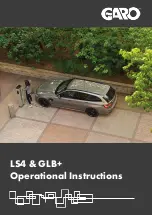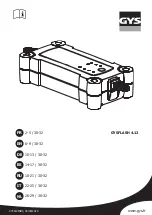
Emergency Operating Procedures
35
3. Turn off all unnecessary electrically
operated accessories in both vehicles with
the exception of those lights needed to
protect the vehicle and light the work area.
4. Turn off the ignition in the vehicle with the
discharged battery. Apply the parking brake
firmly and put the automatic transmission
in ‘P’ (manual transmission in Neutral).
5. Raise the engine compartment cover.
6. Connect one end of RED jumper cable to
the positive cable te which is
fastened to the right side of the engine
compartment, and the other end of this
cable to the positive terminal of the booster
battery Fig. 2.
7. Connect one end of the BLACK jumper
cable to the negative terminal – of the good
battery and the other end to an engine
ground location being started (NOT TO
NEGATIVE (—) TERMINAL OF BATTERY)
taking care that clamps from one cable do
not accidently touch the clamps on the
other cable Fig 2. Connections must be
clean and secure. Cables and connections
must also be clear of any moving
components (pulleys, belts, etc.).
8. Increase the engine speed in the vehicle
with the good battery and let it run for a
few minutes. Then start the engine in the
vehicle with the discharged battery.
9. Carefully disconnect the cables, reversing
the order of the procedure, beginning with
the negative cable attached to the vehicle
with the discharged battery.
Push Starting
To avoid damage to your vehicle DO NOT
attempt to start the engine by pushing with
another vehicle.
Towing
If towing of your vehicle should be required,
please observe the following
recommendations to reduce the possibility of
vehicle damage.
Towing should be carried out using a FLAT
BED towing vehicle.
Freeing Car from Sand, Mud, Snow or Ice
If your car gets stuck in the sand, mud or
snow or ice, move the shift lever on automatic
transmission models from ‘D’ to ‘R’ in a
repeat pattern. (On manual transmission
models, move the sift lever form First or
Second to Reverse). Apply light pressure to
the accelerator pedal while the transmission is
in the ‘D’ or ‘R’ range (First, Second or
Reverse with a manual transmission). Remove
your foot from the accelerator while shifting.
Do not race the engine. For the best traction,
avoid spinning the wheels. Incorrect rocking
of your car while it is stuck may result in
damage to car components.
CAUTION: DO NOT SPIN THE WHEELS
FASTER THAN 2500 RPM LONGER THAN 30
SECONDS. PERSONAL INJURY AND
DAMAGE (INCLUDING TYRE,
TRANSMISSION AND/OR REAR AXLE
FAILURE) MAY RESULT FROM EXCESSIVE
WHEEL SPINNING.
If the car remains stuck after several rocking
attempts, seek other assistance. See also the
Notice under ‘Automatic Transmissions’ in the
‘Steering Column Controls’ section.
Lifting Jack and Wheel Changing
The jack is located in the front wall of the
front luggage compartment. Access is
obtained by turning the two fasteners a
quarter of a turn counter clockwise and lifting
out the panel complete with jack. Unhook
the two remaining straps and remove the jack
Summary of Contents for De Lorean
Page 2: ......
Page 3: ...De Lorean Owner s Handbook Part No 113090 Published by De Lorean Motor Cars 1982 Limited ...
Page 6: ...4 ...
Page 18: ...Controls and Operating 16 ...
Page 43: ......







































